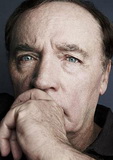“Be gentle,” says planet Earth’s most
prodigious author of bestsellers to New
Arrivals, by way of closing our conversation.  Your correspondent is duly humbled.
James Patterson’s concern is endearing, but frankly unwarranted. His staggering
success is such that he need not give a flying fig what I – or anyone else, for
that matter – make of him.
Your correspondent is duly humbled.
James Patterson’s concern is endearing, but frankly unwarranted. His staggering
success is such that he need not give a flying fig what I – or anyone else, for
that matter – make of him.
The subject of a recent Time magazine feature called “The Man Who Can't Miss,” Patterson has crafted more number one titles (typically crime thrillers and mysteries) in the past five years than Dan Brown, J.K. Rowling, Tom Clancy and John Grisham put together.
The first writer to simultaneously hold the
top spots of both the New York Times adult
and children’s lists, the last 18 of his 34 books have been number one bestsellers.
All told, he’s sold about 100 million copies; in 2005 alone they raked him in around
$40 million. This is a man who’s earned the right to dismiss the Da Vinci Code phenomenon as “no big
deal”.
Some writers are impervious to reviews, and James Patterson has long held that rarefied status. But the lack of respect granted him by the literati – or “literary snobs”, as he has it – is obviously a nagging sore point. He has previously admitted to it being his “biggest frustration”.
Perhaps a desire for critical plaudits is driving his first foray into non-fiction – although he bridles at the suggestion (and won’t be drawn into divulging details of the project). He’s also quick to defend his output to date, saying: “It's not Dickens.” (Indeed, he told the Chicago Tribune in 2001 that when starting his career, “I had decided I didn't have Ulysses in me, but I might have a Day of the Jackal.”)
“I write stuff that's larger than life,” he says today. “It’s supposed to be overblown. I'm not trying to make it like real life.
“Every once in a while somebody will say,
‘Well, this isn't very realistic.’ I always think about someone looking at a
roller-coaster and saying it isn't very realistic. No, it’s a roller-coaster.”
This analogy also scans as an apt metaphor for Patterson’s writing style. Dickens it confirmedly ain’t, but the slick, anonymous prose presents a master-class in breakneck pulp pacing, precisely engineered to propel the reader into serpentine plots at a page-turning rate of knots. The action unfolds in bite-size chapters, of which a typical novel might contain 150, most being just two or three pages long. His paragraphs are short, too; often just a couple of sentences.
“Michael Connelly said something about me in an interview that I think is great: ‘Patterson boils a scene down to the single telling element that defines a character or moves the plot along. It's what fires off the movie projector in the reader's mind.’
“I hadn't really thought of it that way, but I think there's a lot of truth in terms of boiling scenes down to that simple, telling element.”
The taut, hook-laden prose seems informed by Patterson’s origins as an advertising copywriter (he was the youngest ever CEO of the J. Walter Thompson agency). “In creating advertising you soon become aware that there is someone on the other side of the communication that you're putting out,” he says. “And I'm very aware of the audience for my novels. I am respectful of them. I want them to have a good time. I want them to keep reading.
“When I sit down to write, I pretend that
there's one person sitting across from me. I don't want them to get up until
it's over with. No bathroom breaks.” A pertinent rule of thumb for the
occupants of a rollercoaster.
-- Published by New Arrivals magazine, 2006